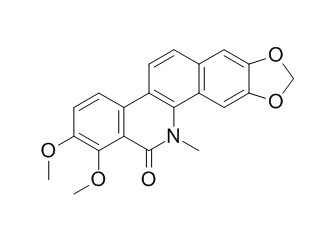Oxychelerythrine
Oxychelerythrine shows high modulatory activity enhancing the susceptibility of the S. aureus ATCC 6538 to all the tested antibiotics from two to four-fold. It also shows antifeeding activities against Tribolium castaneum adults, with the EC50 of 192.32 ppm. enhancing the susceptibility of the S. aureus ATCC 6538 to all the tested antibiotics from two to four-fold.
Inquire / Order:
manager@chemfaces.com
Technical Inquiries:
service@chemfaces.com
Tel:
+86-27-84237783
Fax:
+86-27-84254680
Address:
1 Building, No. 83, CheCheng Rd., Wuhan Economic and Technological Development Zone, Wuhan, Hubei 430056, PRC
Providing storage is as stated on the product vial and the vial is kept tightly sealed, the product can be stored for up to
24 months(2-8C).
Wherever possible, you should prepare and use solutions on the same day. However, if you need to make up stock solutions in advance, we recommend that you store the solution as aliquots in tightly sealed vials at -20C. Generally, these will be useable for up to two weeks. Before use, and prior to opening the vial we recommend that you allow your product to equilibrate to room temperature for at least 1 hour.
Need more advice on solubility, usage and handling? Please email to: service@chemfaces.com
The packaging of the product may have turned upside down during transportation, resulting in the natural compounds adhering to the neck or cap of the vial. take the vial out of its packaging and gently shake to let the compounds fall to the bottom of the vial. for liquid products, centrifuge at 200-500 RPM to gather the liquid at the bottom of the vial. try to avoid loss or contamination during handling.
Chung Shan Medical University2020, US20200323790A1
J Microbiol Biotechnol.2023, 33(10):1317-1328.
Biomed Pharmacother.2024, 175:116770.
J Food Drug Anal.2023, 31(2):254-277.
Eur J Neurosci.2021, 53(11):3548-3560.
Curr Issues Mol Biol.2023, ;45(2):1601-1612.
J Pharmaceut Biomed2020, 182:113110
Preprints2021, doi:10.20944
Front Microbiol.2022, 13:835463.
Sci Rep.2021, 11(1):14180.
Related and Featured Products
Industrial Crops & Products, 2015 , 74 :407-11.
Antifeedant activities of methanol extracts of four Zanthoxylum species and benzophenanthridines from stem bark of Zanthoxylum schinifolium against Tribolium castaneum[Reference:
WebLink]
METHODS AND RESULTS:
Antifeedant activities of the methanol extracts from Zanthoxylum bungeanum, Zanthoxylum schinifolium, Zanthoxylum armatum and Zanthoxylum dissitum were assessed on Tribolium castaneum adults. It was found that the methanol extract of stem bark of Z. schinifolium had the highest antifeedant activity at 41.12% (antifeedant index). Based on bioactivity-guided fractionation, six benzophenanthridines norchelerythrine (1), decarine (2), 8-hydroxy-9-methoxy-2,3-(methylenedioxy) benzophenanthridine (3), 6-hydroxydihydrochelerythrine (4), 6-methoxy-7-hydroxydihydrochelerythrine (5) and Oxychelerythrine (6) were isolated from the stem barks of Z. schinifolium. And their antifeeding activities were also evaluated against T. castaneum.
CONCLUSIONS:
All of them exhibited strong antifeeding activity in a concentration-dependant manner with EC50 of 62.67, 66.97, 151.39, 96.72, 141.61 and 192.32 ppm, respectively. The six bioactive compounds from the stem bark of Z. schinifolium might be used as antifeedants against T. castaneum.
Phytomedicine. 2015 Apr 15;22(4):469-76.
Enhancing activity of antibiotics against Staphylococcus aureus: Zanthoxylum capense constituents and derivatives.[Pubmed:
25925969]
Six compounds (1-6), isolated from the methanol extract of the roots of the African medicinal plant Zanthoxylum capense Thunb. (Rutaceae), and seven ester derivatives (7-13) were evaluated for their antibacterial activities and modulatory effects on the MIC of antibiotics (erythromycin, oxacillin, and tetracycline) and ethidium bromide (EtBr) against a Staphylococcus aureus reference strain (ATCC 6538).
METHODS AND RESULTS:
Using the same model, compounds 1-13 were also assessed for their potential as efflux pump inhibitors by a fluorometric assay that measures the accumulation of the broad range efflux pump substrate EtBr. Compounds 8 and 11 were further evaluated for their antibacterial, modulatory and EtBr accumulation effects against four additional S. aureus strains, which included two clinical methicillin-resistant S. aureus (MRSA) strains. Compounds (1-13) have not shown antibacterial activity at the concentration ranges tested. When evaluated against S. aureus ATCC 6538, Oxychelerythrine (1) a benzophenanthridine alkaloid, showed the highest modulatory activity enhancing the susceptibility of this strain to all the tested antibiotics from two to four-fold. Ailanthoidiol diacetate (8) and ailanthoidiol di-2-ethylbutanoate (11) were also good modulators when combined with EtBr, increasing the bacteria susceptibility by four and two-fold, respectively. In the EtBr accumulation assay, using ATCC 6538 strain, the phenylpropanoid (+)-ailanthoidiol (6) and most of its ester derivatives (8-11) exhibited higher activity than the positive control verapamil. The highest effects were found for compounds 8 and 11 that also increased the accumulation of EtBr, using S. aureus ATCC 25923 as model. Furthermore, both compounds (8, 11) were able to enhance the ciprofloxacin activity against the MRSA clinical strains tested, causing a reduction of the antibiotic MIC values from two to four-fold. The EtBr accumulation assay revealed that this modulation activity was not due to an inhibition of efflux pumps mechanism.
CONCLUSIONS:
These results suggested that Z. capense constituents may be valuable as leads for restoring antibiotic activity against MRSA strains.
Chem Pharm Bull (Tokyo). 2005 Jan;53(1):118-20.
Synthesis of oxychelerythrine using lithiated toluamide-benzonitrile cycloaddition.[Pubmed:
15635245]
METHODS AND RESULTS:
Oxychelerythrine, benzo[c]phenanthridine alkaloid, was synthesized from easily available starting toluamide 5 and benzonitrile 6 using toluamide-benzonitrile cycloaddition reaction in 6 steps.



